The suffocating, scorching hellscape of Venus, with its surface temperatures hot enough to melt lead and an atmosphere thick with carbon dioxide, might just become humanity’s next home. Thanks to artificial intelligence (AI), the idea of transforming Venus into a lush, habitable paradise—a second Earth—is no longer confined to the pages of science fiction. Visionaries like Carl Sagan, who once proposed seeding Venus with algae to reduce its CO2 levels, and modern scientists like Elon Musk, who dreams of colonizing other planets, have laid the groundwork for this audacious vision. Add to that the work of researchers at NASA and ESA, who continue to study Venus’s atmosphere and geology, and you’ve got a recipe for interplanetary transformation. But how do we get from a toxic, inferno-like world to a green, thriving planet? The answer lies in AI-powered terraforming.
1. The Challenges of Venus: Why Terraforming Seems Impossible
1.1 Extreme Atmospheric Pressure
Venus’s atmosphere is like a giant pressure cooker—92 times denser than Earth’s. Standing on its surface would feel like being submerged 3,000 feet underwater. This crushing pressure makes it nearly impossible for human-made equipment to survive, let alone function. Even the sturdiest probes, like Venera 9, have only lasted a few hours before succumbing to the planet’s harsh conditions. AI would need to design materials and systems that can withstand this extreme environment, a challenge that even the most advanced robotics struggle with today.
1.2 Surface Temperature
If you think summer on Earth is unbearable, Venus will make you rethink your complaints. With average temperatures soaring to 460°C (860°F), it’s hotter than Mercury, despite being farther from the Sun. This heat isn’t just uncomfortable—it’s deadly. Metals like lead and zinc would melt on the surface, and most electronics would fail instantly. AI would need to devise cooling mechanisms, such as reflective shields or atmospheric filters, to bring the temperature down to something survivable.
1.3 Toxic Atmosphere
Breathing on Venus is out of the question. Its atmosphere is 96.5% carbon dioxide, with clouds of sulfuric acid that rain down corrosive droplets. Even if we could survive the heat and pressure, the air itself is a death sentence. AI would have to figure out how to convert this toxic mix into something humans can breathe, perhaps by breaking down CO2 into oxygen and carbon-based materials. It’s a massive chemical puzzle, but one that AI is uniquely suited to solve.
1.4 Lack of Water
Water is essential for life, but Venus is drier than a desert. The planet’s surface is so hot that any water would have evaporated eons ago, leaving behind a barren, arid landscape. AI would need to find a way to introduce water, perhaps by bringing hydrogen to react with oxygen in the atmosphere or redirecting icy comets to crash into the planet. Either way, it’s a logistical nightmare that only AI could manage.
1.5 Slow Rotation
Venus takes its sweet time rotating—243 Earth days to complete a single day. This sluggish rotation means one side of the planet is constantly baked in sunlight while the other is plunged into darkness for months. To make matters worse, Venus lacks a magnetic field, leaving it exposed to harmful solar radiation. AI would need to create artificial shielding and possibly even speed up the planet’s rotation to make it more hospitable. It’s a tall order, but in the world of AI, nothing is impossible.
2. The Vision of Terraforming Venus: What Would It Take?
Turning Venus into a second Earth sounds like a plot straight out of a sci-fi blockbuster, but it’s a vision grounded in science. The process would require tackling some of the most extreme challenges in our solar system. Let’s break it down step by step.
2.1 Cooling the Planet
Venus is hot—so hot that it could melt lead like butter on a summer day. To make it habitable, we’d need to cool it down significantly. One idea is to deploy giant solar reflectors or shades in space to block some of the sunlight. Think of it as putting the planet on a cosmic diet. Another approach involves introducing chemicals into the atmosphere to reflect sunlight back into space. It’s like giving Venus a pair of sunglasses, but on a planetary scale.
2.2 Breaking Down CO2
With 96.5% carbon dioxide, Venus’s atmosphere is a greenhouse gas nightmare. To fix this, we’d need to convert that CO2 into something useful—like oxygen and carbon. AI could design nanobots that break down CO2 at a molecular level. It’s like having a tiny army of environmental superheroes saving the day. Alternatively, we could introduce microorganisms (or genetically engineered algae) that do the job naturally. It’s a bit like asking nature to clean up its own mess.
2.3 Creating Water
Water is essential for life, and Venus has virtually none. To solve this, we could introduce hydrogen into the atmosphere, which would react with the oxygen produced from CO2 breakdown to form water. Imagine comets or asteroids delivering hydrogen like cosmic delivery trucks. It’s a wild idea, but with AI managing the logistics, it might just work.
2.4 Stabilizing the Atmosphere
Venus’s atmosphere isn’t just toxic—it’s also incredibly dense. Reducing the pressure would involve removing excess carbon dioxide and introducing lighter gases like nitrogen and oxygen. It’s like swapping out a lead balloon for a helium one. AI could manage this process by optimizing the chemical reactions needed to achieve the right balance.
2.5 Protecting the Surface
Even if we cool Venus and clean up its atmosphere, the planet still lacks a magnetic field to protect it from solar radiation. AI could help design artificial shields or magnetic fields to cover the planet. Picture it as a giant force field, like something out of a superhero movie, but backed by cutting-edge science.
3. Historical Attempts and Theoretical Models of Terraforming
Humans have been dreaming about terraforming Venus for decades. Let’s take a look at the ideas that have shaped this vision and the progress we’ve made so far.
3.1 Carl Sagan’s Proposals
Back in the 1960s, the legendary astronomer Carl Sagan suggested seeding Venus with algae to absorb carbon dioxide and release oxygen, effectively turning the planet into a breathable paradise. While his idea was groundbreaking, we now know Venus’s extreme conditions would fry the algae faster than a bug zapper. Still, Sagan’s vision laid the groundwork for modern terraforming theories.
3.2 Modern Concepts
Today, scientists are exploring more advanced ideas. Solar shields, atmospheric mining, and chemical conversion are all on the table. For example, NASA has proposed using solar-powered drones to study Venus’s atmosphere and test terraforming technologies. It’s like sending robotic scouts to map out the battlefield before the real work begins.
3.3 Current Research
Missions like ESA’s EnVision and NASA’s DAVINCI+ are set to study Venus in unprecedented detail. These missions will provide crucial data on the planet’s atmosphere, geology, and potential for habitability. It’s like sending detectives to solve the mystery of Venus’s deadly secrets.
3.4 AI’s Role in Advancing Theories
AI is already making waves in terraforming research. By simulating millions of scenarios, AI can identify the most efficient ways to cool Venus, break down CO2, and create water. It’s like having a supercomputer play out every possible move in a cosmic chess game. With AI’s help, we’re one step closer to turning this sci-fi dream into reality.
4. Why AI is the Key to Terraforming Venus
When it comes to terraforming Venus, artificial intelligence isn’t just helpful—it’s essential. The sheer complexity of transforming a planet with a toxic atmosphere, crushing pressure, and scorching heat requires a level of precision, adaptability, and problem-solving that only AI can provide. Here’s how AI becomes the ultimate terraforming tool:
4.1 Data Analysis
Venus is a data goldmine, but it’s also a data nightmare. Its atmosphere is a swirling soup of carbon dioxide, sulfuric acid, and extreme weather patterns. Processing this vast amount of information in real-time is beyond human capability. AI, however, can analyze petabytes of data from NASA and ESA missions to identify patterns and anomalies. For example, AI could monitor changes in atmospheric pressure or track the movement of sulfuric acid clouds to inform terraforming strategies.
4.2 Problem-Solving
Terraforming Venus isn’t a single problem; it’s a web of interconnected challenges. How do you cool a planet that’s hotter than Mercury? How do you convert an atmosphere of carbon dioxide into breathable air? AI excels at solving complex, multi-layered problems. Using machine learning algorithms, AI can simulate thousands of scenarios to find the most effective solutions. For instance, it could optimize the design of solar reflectors or predict the outcomes of chemical reactions in Venus’s atmosphere.
4.3 Automation
Venus’s surface is no place for humans. It’s a hellscape that would melt even the most advanced machinery. But AI can control robotic systems from a safe distance, automating tasks like deploying solar reflectors or releasing nanobots to break down CO2. These robots could be engineered to withstand extreme heat and pressure, with AI adjusting their actions in real-time based on environmental feedback.
4.4 Adaptability
Terraforming isn’t a one-and-done process. It’s a dynamic, evolving challenge. What works today might not work tomorrow. AI’s ability to learn and adapt is crucial here. For example, if a solar reflector fails to cool Venus as expected, AI could tweak the design or switch to an alternative method like atmospheric seeding. This adaptability ensures that the terraforming process stays on track, even when faced with setbacks.
4.5 Collaboration
Terraforming Venus will be a global effort, involving scientists, engineers, and policymakers from around the world. AI can act as a coordinator, analyzing input from multiple sources and identifying the best path forward. It could also manage resources efficiently, ensuring that efforts are focused on the most impactful tasks. By fostering collaboration, AI ensures that humanity works as a unified force to achieve this monumental goal.
5. The Ethical and Societal Implications of Terraforming
While the technical challenges of terraforming Venus are immense, they pale in comparison to the ethical dilemmas it raises. Should humans have the right to alter an entire planet? What happens if something goes wrong? These questions force us to confront the moral and societal implications of interplanetary colonization.
5.1 Environmental Ethics
At its core, terraforming is about altering an environment to suit human needs. But is it right to change another planet, even if it’s uninhabitable? Critics argue that humans should focus on fixing Earth’s problems before venturing to other planets. Supporters, however, see terraforming as a way to ensure humanity’s survival. It’s a debate that pits preservation against progress, and AI could play a role in finding a middle ground by proposing solutions that minimize harm to Venus’s natural state.
5.2 Resource Allocation
Terraforming Venus won’t come cheap. It will require trillions of dollars and decades of effort. Is it ethical to invest so much in an interplanetary project when Earth faces pressing issues like climate change, poverty, and inequality? AI could help by calculating the economic and environmental impact of terraforming, ensuring that resources are allocated in a way that benefits both Earth and Venus.
5.3 Colonization Concerns
History shows that colonization often leads to exploitation. Will terraforming Venus repeat these mistakes, or can we create a fair and equitable society from the start? AI could help by designing governance systems that prioritize fairness and inclusivity. For example, it could simulate different social and economic models to identify the most sustainable and just approach for a Venusian colony.
5.4 Long-Term Sustainability
Transforming Venus is just the first step. Maintaining its habitability over centuries will be an even greater challenge. AI could monitor the planet’s atmosphere, ecosystems, and infrastructure, making adjustments as needed to ensure long-term sustainability. This proactive approach could prevent small issues from escalating into catastrophic failures.
5.5 Cultural Impact
Terraforming Venus wouldn’t just change a planet—it would change humanity. How would living on a second Earth reshape our identity, culture, and values? AI could help us explore these questions by analyzing historical patterns of colonization and predicting how a Venusian society might evolve. By understanding these cultural shifts, we can prepare for a future that’s not just technologically advanced but also emotionally and socially fulfilling.
6. AI Solutions: How Would AI Tackle This Issue?
6.1 Data Collection and Analysis
First, AI-powered probes equipped with advanced sensors would be deployed to Venus. These probes, designed by companies like SpaceX or in collaboration with NASA’s Venus exploration missions, would map the planet’s atmosphere, surface, and geological activity. AI algorithms would process this data in real-time, identifying patterns and anomalies that would inform the next steps. Think of it as a planetary MRI, but with AI as the radiologist. This phase would also involve partnerships with institutions like Caltech and the European Space Agency (ESA) to ensure accuracy and scalability.
6.2 Atmospheric Conversion
Next, AI would design and deploy nanobots capable of breaking down Venus’s thick carbon dioxide atmosphere into oxygen and graphite. These nanobots, inspired by breakthroughs in nanotechnology from MIT and Stanford University, would operate autonomously, guided by AI to maximize efficiency. Imagine trillions of microscopic workers, each programmed to perform a specific chemical reaction, turning CO2 into breathable air and usable materials. This process would be monitored and optimized by AI systems housed in orbiting satellites, ensuring minimal energy consumption and maximum output.
6.3 Temperature Regulation
To cool Venus’s surface, AI would manage the deployment of massive solar reflectors. These reflectors, constructed from lightweight materials developed by companies like Lockheed Martin, would deflect sunlight away from the planet, gradually reducing temperatures. AI would also control weather-modifying systems, introducing cooling agents into the atmosphere. Think of it as a planetary thermostat, controlled by an AI-powered “smart home” system. Collaborations with climate scientists from Oxford University would ensure these interventions are sustainable and effective.
6.4 Water Creation
AI would orchestrate the introduction of hydrogen to Venus, either through controlled cometary impacts or chemical reactions. The hydrogen would react with atmospheric oxygen to form water, a critical resource for life. This phase would involve partnerships with DOE and private companies like Boeing to ensure precision and safety. AI would simulate and predict the outcomes of these interventions, minimizing the risk of unintended consequences. Picture an AI-driven chemistry lab, operating on a planetary scale.
6.5 Ecosystem Building
Finally, AI would simulate and deploy self-sustaining ecosystems on Venus. Drawing on research from Harvard and the Smithsonian Institution, these ecosystems would be designed to thrive in Venus’s newly habitable environment. AI would monitor their growth and evolution, making real-time adjustments to ensure balance and sustainability. Think of it as a gardener, but one who can tend to an entire planet.
Action Schedule/Roadmap
- Day 1: Assemble a task force of AI experts, planetary scientists, and engineers. Key personnel include representatives from SpaceX, NASA, ESA, and MIT.
- Week 1: Launch AI-powered satellites to study Venus’s atmosphere and surface. Utilize imaging and spectroscopic technologies to gather comprehensive data.
- Month 1: Begin development of nanobots for CO2 conversion. Collaborate with nanotechnology labs at Stanford University and Caltech to refine designs.
- Month 3: Design and test solar reflectors using AI simulations. Partner with Lockheed Martin for manufacturing and deployment logistics.
- Year 1: Test nanobots and reflectors in controlled environments mimicking Venus’s atmosphere. Use AI to analyze results and optimize performance.
- Year 1.5: Deploy nanobots and solar reflectors on Venus. AI systems will manage and monitor the deployment, ensuring seamless execution.
- Year 2: Monitor progress and adjust AI algorithms for optimal results. Conduct regular assessments in collaboration with global partners like Oxford University and Harvard.
A New Era of Possibilities: The Future of Venus Terraforming
The transformation of Venus into a second Earth is no longer a distant dream but a tangible possibility with the power of AI. By leveraging advanced technologies, humanity could not only expand its horizons but also ensure its survival in the face of Earth’s growing challenges. While the journey will be fraught with difficulties, the potential rewards—a habitable planet and a new chapter in human history—are worth the effort. Imagine stepping onto a green, vibrant Venus, its skies blue and its air fresh, a testament to human ingenuity and the limitless possibilities of AI. This vision, once confined to science fiction, is now within our grasp.
The success of this endeavor will require global collaboration, ethical considerations, and a commitment to long-term sustainability. It will also redefine what it means to be human, pushing us to think beyond our planet and embrace a future where the stars are not just a destination but a home. As we stand on the precipice of this new era, one question remains: are we ready to take the leap?
Frequently Asked Questions (FAQ)
Q1: Is terraforming Venus scientifically possible?
Yes, terraforming Venus is scientifically possible, though it comes with enormous challenges. Scientists have proposed various theoretical models, and advancements in AI and robotics could make these models a reality. For example, NASA and the European Space Agency (ESA) are already studying Venus’s atmosphere and geology to better understand its potential for transformation. While it sounds like science fiction, progress in technology could turn this dream into reality.
Q2: How long would it take to terraform Venus?
Estimates vary widely, but most experts agree terraforming Venus would take centuries or even millennia. Here’s a breakdown of the timeline:
- Short-term (1-10 years): Launch AI-powered probes to study Venus’s atmosphere and surface.
- Mid-term (10-100 years): Begin deploying AI-driven technologies like solar reflectors and CO2-converting nanobots.
- Long-term (100-1,000 years): Gradually cool the planet, stabilize the atmosphere, and introduce water and ecosystems.
Of course, this timeline could shorten dramatically if we make unexpected breakthroughs in AI and engineering.
Q3: Would terraforming Venus damage the planet?
Terraforming would fundamentally alter Venus, but the goal isn’t to preserve its current state—it’s to make it habitable for humans and other Earth-based life. Critics argue that altering another planet raises ethical questions, but proponents believe it’s a necessary step for humanity’s survival and expansion. After all, Venus is already uninhabitable in its current form, so transforming it could be seen as an improvement.
Q4: What role would humans play in terraforming Venus?
Humans would oversee the process, make ethical decisions, and guide the development of AI technologies. While AI would handle the heavy lifting—like analyzing data, designing solutions, and managing robotic systems—humans would ensure everything aligns with our goals and values. Think of it as a partnership: AI is the worker, and humans are the architects.
Q5: Could AI make mistakes during terraforming?
AI is highly capable, but it’s not perfect. Mistakes could happen, especially in such a complex and unprecedented project. However, rigorous testing, oversight, and continuous learning would minimize these risks. AI systems could also adapt and improve over time, making them more reliable as the project progresses. It’s important to remember that AI is a tool, and its success depends on how well we program and guide it.
Q6: What would be the biggest challenge in terraforming Venus?
The biggest challenge is Venus’s extreme atmosphere. With a surface temperature of over 460°C (860°F) and air pressure 92 times that of Earth, creating a habitable environment would require massive changes. Breaking down the thick layers of carbon dioxide and cooling the planet are two of the most daunting tasks. However, AI could help us develop innovative solutions, like solar reflectors or nanobots that convert CO2 into oxygen.
Q7: How would we create water on Venus?
Venus has almost no water, which is essential for life. One proposed solution is to introduce hydrogen into the atmosphere, where it could react with oxygen to form water. AI could help manage this process by calculating the exact amounts needed and ensuring the reactions occur safely. Another idea is to redirect comets or asteroids rich in water ice to collide with Venus, though this would require precise planning and execution.
Q8: Would terraforming Venus benefit Earth?
Absolutely! Learning how to terraform Venus could teach us valuable lessons about managing Earth’s environment. For example, breakthroughs in CO2 conversion or temperature regulation could help combat climate change. Additionally, establishing a second habitable planet would provide humanity with a backup plan in case of catastrophic events on Earth. It’s a win-win scenario for both planets.
Q9: Who would fund such a massive project?
Terraforming Venus would likely require a global effort, funded by governments, private companies, and international organizations. Tech giants like Google and SpaceX might play a key role, as they’re already investing in space exploration. Crowdfunding and public support could also help raise the necessary resources. It’s a project that would unite humanity in a shared goal.
Q10: What happens if we fail?
Failure is always a possibility, but even unsuccessful attempts could yield valuable knowledge. For example, studying Venus’s atmosphere and testing terraforming technologies could advance our understanding of planetary science and environmental engineering. And who knows? Lessons learned from Venus might help us terraform other planets, like Mars, more successfully.
Wait! There's more...check out our gripping short story that continues the journey: The Surface Equation
Disclaimer: This article may contain affiliate links. If you click on these links and make a purchase, we may receive a commission at no additional cost to you. Our recommendations and reviews are always independent and objective, aiming to provide you with the best information and resources.
Get Exclusive Stories, Photos, Art & Offers - Subscribe Today!





























Post Comment
You must be logged in to post a comment.